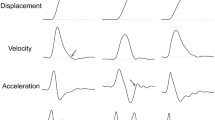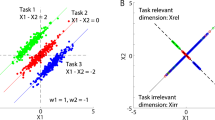Abstract
Evidence for the existence of discrete submovements underlying continuous human movement has motivated many attempts to “extract” them. Although they produce visually convincing results, all of the methodologies that have been employed are prone to produce spurious decompositions. In previous work, a branch-and-bound algorithm for submovement extraction, capable of global nonlinear minimization, and hence, capable of avoiding spurious decompositions, was presented [Rohrer and Hogan (Biol Cybern 39:190–199, 2003)]. Here, we present a scattershot-type global nonlinear minimization algorithm that requires approximately four orders of magnitude less time to compute. A sensitivity analysis reveals that the scattershot algorithm can reliably detect changes in submovement parameters over time, e.g., over the course of neuromotor recovery.
Similar content being viewed by others
References
Berthier NE (1996) Learning to reach: a mathematical model. Dev Psychol 32:811–823
Burdet E, Milner TE (1998) Quantization of human motions and learning of accurate movements. Biol Cybern 78:307–318
Collewijn H, Erkelens CJ, Steinman RM (1988) Binocular coordination of human horizontal saccadic eye movements. J Physiol 404:157–182
Crossman ERFW, Goodeve PJ (1983) Feedback control of hand-movements and Fittć6s law. Q J Exp Psychol A 35:251–278
Doeringer JA (1999) An investigation into the discrete nature of human arm movements. PhD thesis, Massachusetts Institute of Technology
Flash T, Henis E (1991) Arm trajectory modifications during reaching towards visual targets. J Cogn Neurosci 3:220–230
Hogan N (1984) An organizing principle for a class of voluntary movements. J Neurosci 4:2745–2754
Krebs HI (1997) Robot-aided neurorehabilitation and functional imaging. PhD thesis, Massachusetts Institute of Technology
Lee D, Port NL, Georgopoulos AP (1997) Manual interception of moving targets II: on-line control of overlapping submovements. Exp Brain Res 116:421–422
Little JDC, Murty KG, Sweeney DW, Karel C (1963) An algorithm for the traveling salesman problem. Oper Res 11: 972–989
Milner TE (1992) A model for the generation of movements requiring endpoint precision. Neuroscience 49:365–374
Morasso P (1981) Spatial control of arm movements. Exp Brain Res 42:223–227
Morasso P, Mussa-Ivaldi FA (1982) Trajectory formation and handwriting: a computational model. Biol Cybern 45:131–142
Plamondon R (1992) A theory of rapid movements. In: Stelmach GE, Requin J (eds) Tutorials in motor behavior II. Elsevier, Amsterdam, pp 55–69
Plamondon R, Alimi AM, Yergeau P, Leclerc F (1993) Modeling velocity profiles of rapid movements: a comparative study. Biol Cybern 69:119–128
Rohrer B, Fasoli S, Krebs HI, Hughes R, Volpe B, Frontera WR, Stein J, Hogan N (2002) Movement smoothness changes during stroke recovery. J Neurosci 22:8297–8304
Rohrer B, Hogan N (2003) Avoiding spurious submovement decompositions: a globally optimal algorithm. Biol Cybern 89:190–199
Rohrer B, Fasoli S, Krebs HI, Hughes R, Volpe B, Frontera WR, Stein J, Hogan N (2004) Submovements grow larger, fewer, and more blended during stroke recovery. Motor Control 8:472–483
Vallbo AB, Wessberg J (1993) Organization of motor output in slow finger movements in man. J Physiol 469:673–691
von Hofsten C (1991) Structuring of early reaching movements: a longitudinal study. J Mot Behav 23:280–292
Woodworth RS (1899) The accuracy of voluntary movement. Psychol Rev Monogr Suppl
Author information
Authors and Affiliations
Corresponding author
Rights and permissions
About this article
Cite this article
Rohrer, B., Hogan, N. Avoiding Spurious Submovement Decompositions II: A Scattershot Algorithm. Biol Cybern 94, 409–414 (2006). https://doi.org/10.1007/s00422-006-0055-y
Received:
Accepted:
Published:
Issue Date:
DOI: https://doi.org/10.1007/s00422-006-0055-y




